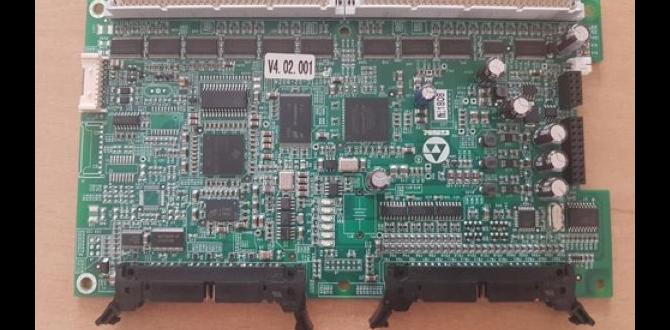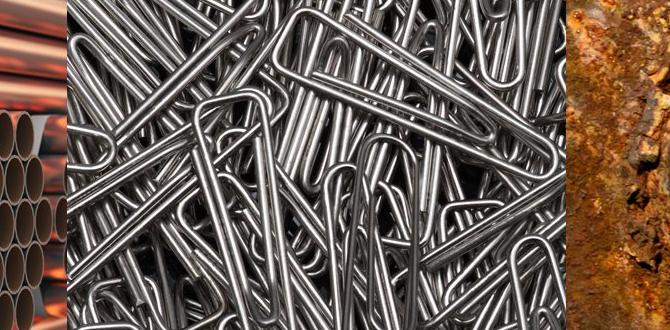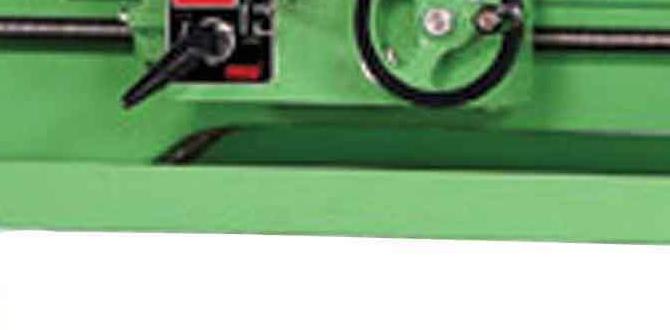Mastering Your Metal Lathe: A Beginner’s Guide to Essential Operations
Are advanced machining techniques intimidating? This guide demystifies the metal lathe, milling tools, and woodworking lathes for beginners. Learn fundamental operations, essential tool choices, and safe practices to confidently tackle your first projects. We’ll break down complex processes into simple, actionable steps, ensuring you achieve precise, reliable results with ease.
Hello there! Daniel Bates here, your guide to getting started with the fascinating world of machining. I know that stepping up to a metal lathe, understanding milling tools, or even getting the hang of a woodworking lathe can feel like a big leap. There’s a lot of jargon, and sometimes it seems like everyone else already knows the “secret handshake.” But guess what? It doesn’t have to be that way. My goal is to make these incredible tools accessible and, dare I say, fun for you. We’ll go through everything you need to know, step by step, to feel confident and safe. Ready to turn metal into something amazing? Let’s dive in!
Getting Started with Your Metal Lathe: The Absolute Basics
So, you’ve got a metal lathe, or you’re thinking about getting one. That’s fantastic! The metal lathe is one of the most versatile machines in any workshop, capable of shaping metal with incredible precision. But before we start spinning, it’s crucial to understand the absolute fundamentals. For beginners, this means getting familiar with the machine itself, its basic functions, and how to operate it safely.
Understanding Your Metal Lathe Components
Every machine has its parts, and knowing them is like knowing your way around a kitchen before you cook. Let’s break down the core components of a typical metal lathe:
Headstock: This is the part that houses the motor and the spindle. The spindle rotates, and you’ll mount your workpiece or chuck onto it.
Tailstock: Located on the opposite end of the bed from the headstock, the tailstock offers support for longer workpieces and can hold tools like drill bits or reamers.
Bed: The main structural element of the lathe, providing a rigid foundation for all other components.
Carriage: This moves along the bed and carries the tool post. It controls the cutting tool’s movement.
Cross Slide: Mounted on the carriage, this allows for in-and-out cuts (facing and parting off).
Compound Rest: This sits on top of the cross slide and can be swiveled to make angled cuts or tapers.
Tool Post: This holds the cutting tool in place on the carriage.
Lead Screw/Feed Rod: These are used to automatically advance the cutting tool along the bed (longitudinal feed) or across the face (cross feed).
Safety First, Always!
Before you even think about turning it on, safety is paramount. Metal lathes can be dangerous if not operated correctly.
Always wear safety glasses. No exceptions. Flying chips of metal are no joke.
No loose clothing, jewelry, or long hair. These can get caught in the rotating parts. Tie your hair back and remove rings or bracelets.
Know your emergency stop. Make sure you can quickly and easily shut off the machine in an emergency.
Don’t wear gloves. This is counter-intuitive for some, but gloves can get snagged and pull your hand into the machine. You need to feel what’s happening.
Work area cleanliness: Keep chips swept away regularly. They can build up and create tripping hazards or interfere with the machine’s operation.
Secure the workpiece properly. A loose workpiece can fly off the lathe, causing serious injury.
Never leave a running machine unattended.
Basic Metal Lathe Operations for Beginners
Once you’re comfortable with the machine and safety protocols, you can start exploring the basic operations. We’ll begin with the most common ones.
1. Facing
Facing is the process of creating a flat surface on the end of a workpiece. This is often one of the first operations you’ll learn because it’s fundamental for creating reference surfaces.
Steps for Facing:
Secure your workpiece: Mount your material in the chuck. Ensure it’s centered and gripped firmly.
Set up the tool: Place a suitable facing tool (like a right-hand turning tool) in the tool post. Position it so the cutting edge is level with the center of the workpiece.
Set the cross slide: Adjust the cross slide so the tool bit is just at the outer edge of the face you want to create.
Initiate the cut: Start the lathe at a slow to medium speed. Advance the cross slide gently to make the cut. You’ll be moving the tool across the face of the workpiece.
Take light cuts: Especially when learning, take shallow cuts. This is safer, easier to control, and produces a better finish. Advance the tool progressively until you reach the desired diameter or center.
2. Straight Turning (External)
Straight turning involves reducing the diameter of a cylindrical workpiece. This is the bread and butter of lathe work.
Steps for Straight Turning:
Secure your workpiece: Mount and center your material.
Set up the tool: Install a turning tool (e.g., a HSS (High-Speed Steel) or carbide-tipped bit) in the tool post. Align its cutting edge with the center of the workpiece.
Position the tool: Bring the tool bit to the outer edge of the material you want to remove.
Set the feed: Engage the longitudinal feed (either by handwheel or power feed) to move the tool along the length of the workpiece.
Make the cut: Start the lathe. Advance the tool into the work (cross slide) to the desired depth of cut, then engage the feed to move it lengthwise.
Take multiple passes: For significant diameter reductions, plan on several passes, each taking a little material. This is more controlled and less taxing on the tool and the machine.
3. Parting Off (Grooving)
Parting off is used to cut a finished piece from the stock material or to create grooves. It’s a critical operation but requires care.
Steps for Parting Off:
Secure the workpiece: Ensure it’s mounted securely.
Set up the parting tool: Use a narrow parting tool. Position it on the cross slide.
Align the tool: It’s crucial that the parting tool is set exactly at the center height of the workpiece. If it’s above center, it will tend to dig in and break; if below, it won’t cut effectively.
Engage the cross slide: Start feeding the parting tool into the workpiece using the cross slide.
Use slow speed and steady feed: A slow spindle speed combined with a steady feed rate is key to a clean parting cut.
Cut only partway if needed: Sometimes for large diameter stock, you’ll cut partway, then move the carriage back, and continue the cut from the other end if possible, or use the tailstock for support if it’s long.
Essential Lathe Tools for Beginners
You don’t need a massive toolbox to start, but a few key tools will make your life much easier and safer.
Chuck: This is what holds your workpiece. Common types include 3-jaw (self-centering) and 4-jaw (independent, for odd shapes).
Centers: Used for supporting work between the headstock and tailstock.
Cutting Tools (Inserts or HSS): You’ll need tools for turning, facing, and parting. HSS (High-Speed Steel) is often recommended for beginners as it’s more forgiving and cheaper.
R8 or Morse Taper Collets/Arbors: Depending on your machine, these are used for holding smaller diameter workpieces or tools precisely.
Measuring Tools:
Calipers: Inside and outside calipers for rough measurements.
Micrometer: For precise measurements. Essential for accuracy.
Ruler/Scale: For general checks.
Here’s a table summarizing some common lathe operations and their primary tools:
| Operation | Primary Tool | Description |
|---|---|---|
| Facing | Facing Tool (Right-hand or Left-hand) | Creates a flat end surface. |
| Straight Turning | Turning Tool (Right-hand or Left-hand) | Reduces the outer diameter of a workpiece. |
| Parting Off | Parting Tool | Cuts a finished piece from the stock or creates grooves. |
| Drilling | Drill Bit (held in tailstock) | Creates a hole on the end or center of a workpiece. |
| Taper Turning | Compound Rest/Taper Attachment | Creates an angled surface. |
Introduction to Milling Tools and Techniques
Milling machines are incredibly powerful tools for creating flat surfaces, slots, pockets, and complex shapes in metal. While a lathe shapes material by spinning the workpiece, a milling machine cuts material by spinning a cutting tool while the workpiece is moved against it. For beginners, understanding the basic types of milling and the tools involved is key to safe and effective operation.
Types of Milling
There are two primary types of milling that you’ll encounter:
Face Milling: Involves a cutter that has teeth on its periphery and end. The face of the cutter rotates and removes material, creating a flat surface. This is great for surfacing large areas.
Peripheral Milling (or Slab Milling): Uses a cutter that has teeth only on its circumference. This type of milling is used to create slots, pockets, and shallower cuts.
Within peripheral milling, there are two approaches:
Climb Milling: The cutter rotates in the same direction as the workpiece is moving. This can result in a smoother finish and less force, but requires a rigid machine and can be harder to control for beginners.
Conventional Milling: The cutter rotates against the direction of the workpiece movement. This is generally easier to control and more forgiving for beginners because the cutting forces help to pull the workpiece into the cutter, making it less likely to wander.
Essential Milling Tools and Cutters
The cutting tools used in milling machines are called end mills. There are many types, but for beginners, understanding a few key ones is enough to get started.
Two-Flute End Mill: These are versatile and work well for slotting and general-purpose milling. They have good chip-clearing capabilities.
Four-Flute End Mill: Better for finishing operations and for materials that tend to produce stringy chips.
Ball End Mill: Has a rounded end, used for creating curved surfaces and pockets.
Square End Mill: The most common type, with flat, sharp corners.
Carbide vs. HSS End Mills
You’ll often see end mills made from High-Speed Steel (HSS) or Solid Carbide.
HSS End Mills: Generally more affordable and tougher (less brittle). Good for general machining and can be resharpened more easily.
Carbide End Mills: Much harder and can cut at higher speeds, leading to faster material removal and longer tool life, especially in harder materials. They are more brittle and can chip or break if mishandled or if the setup is not rigid.
For machining plastics like nylon, carbide end mills are often preferred. They maintain their sharpness at higher speeds and create a cleaner cut, reducing the risk of melting or gumming up the material. A 1/8 inch (3mm) or 1/4 inch (6mm) shank is common for smaller, detailed work. A reduced neck can be beneficial for reaching deeper into pockets without the flute diameter binding, and low runout is crucial for accuracy and finish, especially with small diameter tools.
Setting Up a Milling Operation
1. Secure the Workpiece: Use clamps, vices, or other fixtures to hold your workpiece firmly to the milling machine table.
2. Select and Mount the Cutter: Choose the appropriate end mill for your material and operation. Mount it securely in a collet or tool holder in the milling machine’s spindle.
3. Set the Z-Axis Zero (Depth): Carefully bring the tip of the end mill down to the surface of your workpiece and set your Z-axis DRO (Digital Readout) or indicator to zero. This is crucial for controlling the depth of cuts.
4. Set the X and Y Axis Zero: Position the cutter at the desired starting point on your workpiece and set your X and Y DROs to zero.
5. Program or Manually Feed: Depending on the machine, you’ll either program the toolpath or manually feed the table using the handwheels.
6. Make the Cut: With the spindle running at the correct speed, slowly feed the workpiece into the rotating cutter. Take light cuts, especially when learning.
An excellent resource for machining practices, including milling, can be found at the National Institute of Standards and Technology (NIST) Manufacturing Metrology Handbook, which provides foundational knowledge on measurement and manufacturing processes.
Wood Lathe Basics: Turning Wood Smoothly
Whether you’re making bowls, spindles, or decorative items, the woodworking lathe is a fantastic tool for shaping timber. Unlike metal lathes, wood lathes generally spin faster and require different safety considerations. The goal is to remove wood efficiently while creating a smooth, symmetrical, and safe finished product.
Understanding Your Wood Lathe
The core components are similar to a metal lathe but designed for wood:
Headstock: Contains the motor and spindle. It also often has a speed control.
Tailstock: Provides support for the free end of the workpiece and can hold drill bits for hollowing bowls.
Bed: The main frame.
Tool Rest: This is where you support your cutting tools as they engage the wood. Adjusting its position is critical.
Drive Center (Headstock) & Spur Center (Tailstock): These are used to grip and drive the workpiece.
Wood Lathe Safety Essentials
Wood turners face unique risks, primarily from the wood itself and the tools.
Safety Glasses or Face Shield: Always. Wood chips can fly at high speed.
Dust Mask/Respirator: Wood dust is a health hazard.
No Loose Clothing/Hair: Same rule as metal lathes.
Secure Workpiece: Ensure your wood is firmly mounted between centers or in a chuck.
Tool Rest Position: The tool rest should be close to the workpiece (but not touching) and positioned below the center line for most spindle turning, and slightly above center for bowls. This helps prevent catches.
Sharp Tools: Dull tools are more dangerous as they require more force and are more prone to catching.
Stand to the Side: Never stand directly in line with the workpiece. If it comes flying off, you’ll want to be out of the direct path.
Basic Wood Lathe Operations
Mounting the Wood:
Between Centers: For spindle turning (like legs for furniture). You’ll use a drive spur in the headstock and a live center in the tailstock.
In a Chuck: For bowl turning. A chuck grips the rim of the wood.
Spindle Turning: This involves turning a piece of wood between centers to create uniform diameters, tapers, and decorative details.
Roughing Out: Use a large, heavy roughing gouge to quickly remove square stock and bring it close to a cylinder. Always engage the wood with the gouge at a slight angle.
Using a Skew Chisel: For creating smooth surfaces and beveled details. Requires precise technique to avoid catches.
Parting Tool: Used to cut grooves or to cut the finished piece off the stock.
Bowl Turning: This is done holding the wood in a chuck.
Face Turning: Similar to metal lathe facing, creating a flat surface.
Hollowing: Using a bowl gouge to carefully remove material from the face of the bowl. This is often done in stages, removing material from chuck to tailstock, then reversing the bowl and hollowing the other side.
Essential Wood Lathe Tools
Gouges:
Roughing Gouge: For quickly removing material and shaping cylinders.
Spindle Gouge: For detailing and creating smooth surfaces on spindles.
Bowl Gouge: Specifically designed for cutting bowls, with a curved flute.
Skew Chisel: Used for scraping and cutting to create smooth surfaces and coves.
Parting Tool: For cutting grooves and separating finished pieces.
Scrapers: Various shapes (round nose, flat) used for smoothing surfaces, especially on bowls.
Chucks: For securely holding bowls and other irregular shapes.
For more in-depth information on woodturning, the Wood Magazine website offers numerous articles and guides for woodworkers of all levels.
Advanced Considerations for Specific Materials (Nylon Example)
When using your milling tools, especially with smaller, precise end mills like our example of a “carbide end mill 1/8 inch 6mm shank reduced neck for nylon low runout,” material selection and machining parameters become critical.
Nylon is a common plastic used in many mechanical parts, from gears to bushings. It can be machined but has specific characteristics:
* Low Melting Point






